
Nippon2
.pdf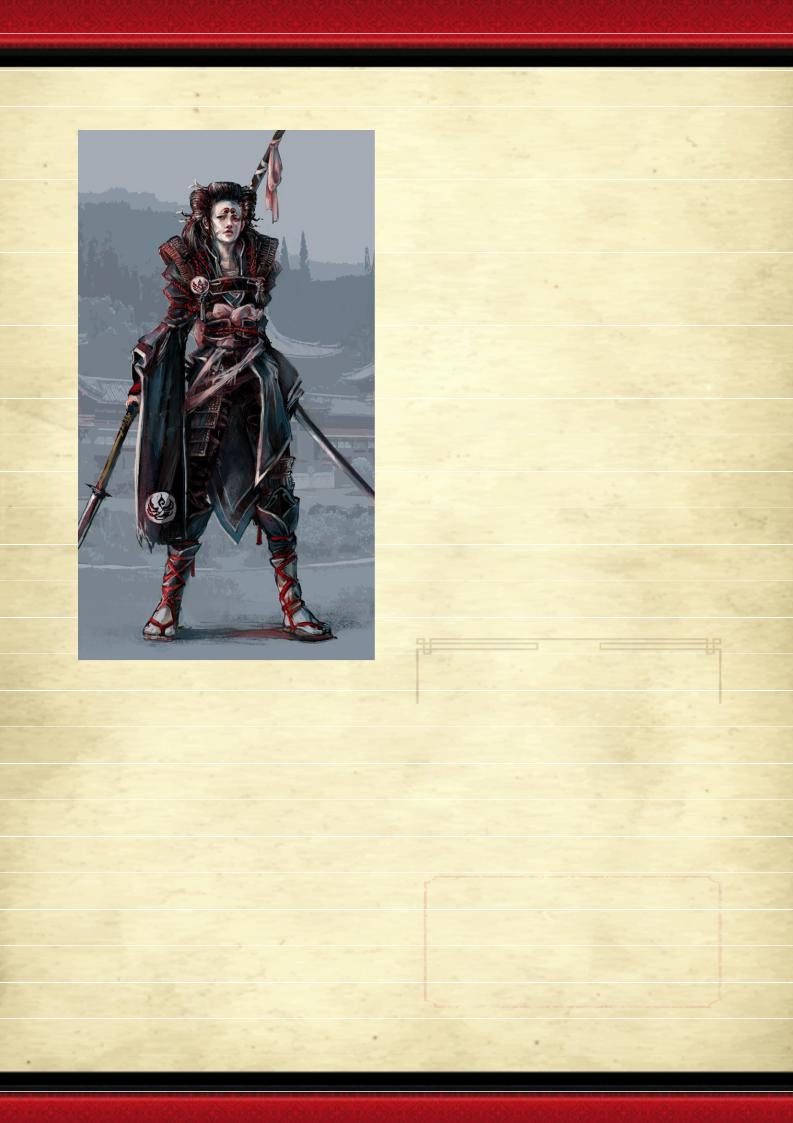
BAT TLE MAIDENS
In Nippon, a woman's caste - not her gender - constitutes her position in the Celestial Order. As such, any woman who so wishes may become a samurai, earning the same rights and respect as t heir male counterparts.
Battle Maidens are treated with the defe rence due a lady of their station, unless they are dressed and prepared for war. If a Battle Maiden is dressed in 'mannish' attire, she is referred to with h er military title. Female samurai are treated with the sam e respect as their male counterparts though they are typically expected to be softer-spoken and more lady-like in most clans.
This varies from clan to clan, with som e families being strictly matriarchal. Some have in fact h igher standards for their Battle Maidens than they have for their men, an expectation of chastity and honour not held to many men in the Empire.
One of the favourite stories of Nippone se poets is of the sister of a murdered samurai who pu t on her
61
brother's armour and took up his sword to avenge him. “Hitomi’s Tale” has moved many young women to become samurai, and has justified the act in the eyes of many daimyos. The samurai ritual of changing one's name has brought many Battle Maidens female samurai - to take the name “ Hitomi” upon taking the daisho.
One of the vows that some B attle Maiden take during their initiation ceremony is a vow of celibacy, as a Battle Maiden cannot he devoted to both a daimyo and a lover or husband, after all. If a celibate Battle Maiden is found to have a lover, she often renounces her station and joins the ranks of a monastery. Of course, the key word is “discovered” There are many Battle Maidens who take lovers, and every poet's repertoire has several stories of samurai and Battle Maidens who doom themselves for love. Battle Maidens are treated as samurai warriors in the Ce lestial Order. They are no different from male samurai in that regard.
Battle Maidens are usually a rmed with the naginata, a long pole arm that is tipped with a deadly curved sword-blade. They favour a defensive strategy over assault. Since they lack the physical strength of the men, they have instead beco me very proficient at holding their foes at bay wit h their naginata until reinforcements can arrive and finish them off.
Nipponese women are trained to defend their homes in times of war but few take pa rt in open battle. Those who do though, quickly beco me legends.
|
M WS BS S T W I A Ld |
||||||||
Battle Maiden |
4 |
4 |
4 |
3 |
3 |
1 |
4 |
1 |
8 |
Onna-Bugeisha |
4 |
4 |
4 |
3 |
3 |
1 |
4 |
2 |
8 |
TROOP TYPE: Infantry.
SPECIAL RULES: Way of the Warrior, Kenjutsu,
Death before Dishonour.
Stalwart Defence: Enemies charging a unit of Battle Maidens to the front lose all charging bonuses. In addition, Battle Maidens ma y re-roll failed Break Tests.
“Samurai maidens who remain faithful to their lords get their name in the history books. The ones who fall find their nam es in tragic love songs.”
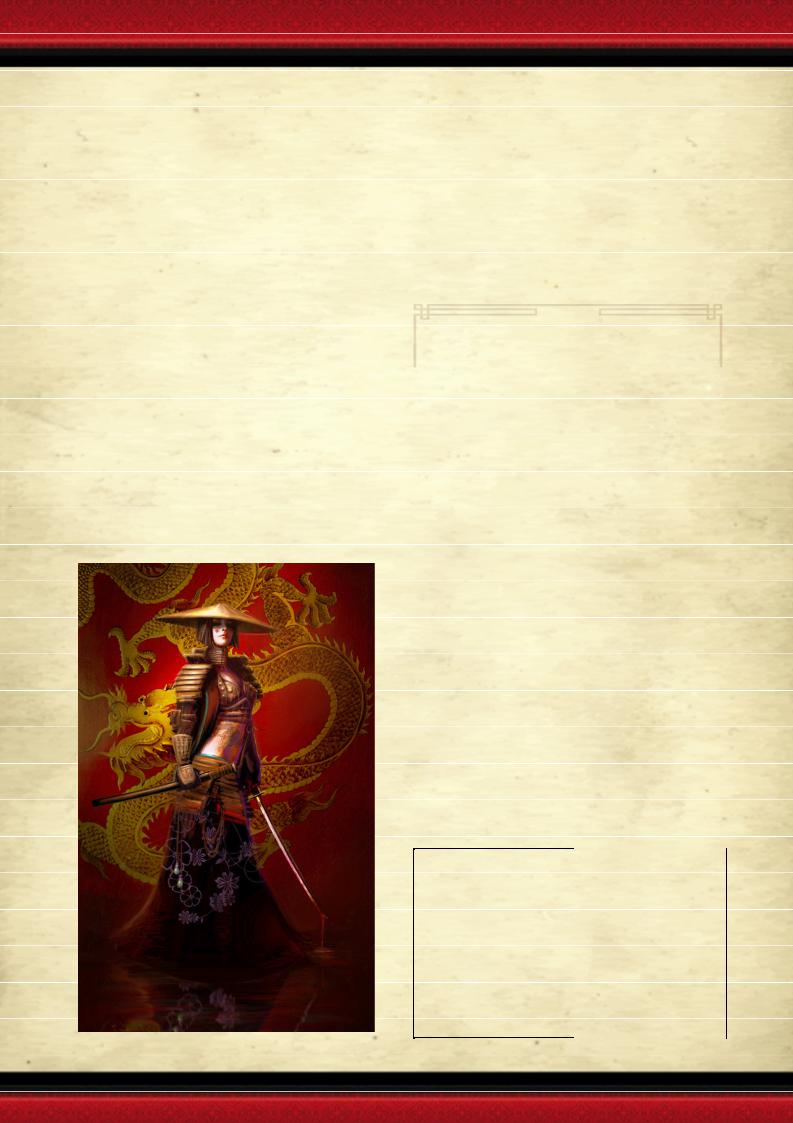
K ABUKI DOLLS
Kabuki is one of the most common for ms of theatre in Nippon, and focuses on lively and almost violent action, dancing and tension. Singers an d orchestra often provide the backdrop for the actors and key information about the setting. The name Kabuki comes from the word kabuki-odori which mea ns "stylish and shocking dances". The plays make use of elaborate costumes, makeup, sets and special effects to accompany the story, and the actors move in special stylized patterns known as kata. The set is changed by stagehands dressed entirely in black dur ing the show, and the stage contains many trapdoors a nd rotating platforms to aid in this endeavour. There are two major types of Kabuki plays; the jidaimono, or "rough stuff style", and the sewamono, the "talk of t he town".
Most performers of Kabuki theatre are professional dancers and actors; however a small an d secretive cult of masked assassins also trains its members in Kabuki, treating the intricate gestures and extre me posturing of the dance as the basis for a martial art f orm. These Kabuki Dolls, as they are called, receiv e lifelong training in diverse arts, from assassination, protection, and diplomacy, to proficiency with exo tic and traditional weapons like the battle-fan and poisoned hair needles, as well as skill with a musical instrument, rhetorical excellence, and of course Kab uki dance.
Some nobles flaunt their Kab uki Doll escorts when in public, as it is a great status s ymbol in society to own one, and accomplished Kabuki Dolls can command the price of a small mansion for a single evening’s entertainment - or a single, spectacular kill.
Though the battlefield is not their ideal environment, units of Kabuki Dolls make very effective combat troops, and their expertise in the martial arts, bravery and dedication to duty are second to none.
|
M WS BS S T W I A Ld |
||||||||
Kabuki Doll |
5 |
4 |
4 |
3 |
3 |
1 |
5 |
1 |
8 |
Dai-jô |
5 |
4 |
4 |
3 |
3 |
1 |
5 |
2 |
8 |
TROOP TYPE: Infantry.
SPECIAL RULES: Skirm ishers, Poisoned
Attacks.
Kabuki Dance: Kabuki is a n ancient stylised dance form of such complexity and nuance that only the most cultivated of aficionados can truly appreciate its subtleties. Revitalized and ad apted for the tastes of the more traditional-minded clan leaders it has become an iconographic form of status entertainment in Nippon. The Kabuki Dolls can use the skills of their trade in battle as well, favouring the two major types of jidaimono and sewamono.
You must choose one of the two dances for the kabuki Dolls to perform at the start of each close combat phase.
Jidaimono: Yelling and bra ying their often nonsensical lines, the Kabuki Dolls throw themselves at the foe in a flurry of death.
While performing this dance, the Kabuki Dolls have the Always Strikes First spec ial rule and +1 Strength.
Sewawono: Moving gracefully and without pause, the Kabuki Dolls dodge strike after strike.
While performing this dance, enemies must re-roll all successful rolls to Hit against the Kabuki Dolls. In addition, they add +2 to their Parry save.
WAR FAN
Fans are often used in Nippo n by courtiers to hide their faces, and by generals to signal the troops. Eventually it was developed into a weapon as well. The War Fan was primarily developed to be defensive but it can also be used to strike blo ws with its sharp, metal edges.
A War Fan may be used in t wo ways: it can either be used as an additional hand weapon with the Jidaimono style or as a shield in close combat with the Sewamono style.
62

YABUSAME
The Yabusame are a special caste of Samurai that excel in the art of Kyudo archery. They train tirelessly daily to improve their skills while firing from galloping horseback, and hold great tournaments t o find the best amongst themselves. This is done by rid ing past three targets and shooting at them at high speed. They wear traditional hunting attires while doing s o, both in tournaments and in battle, as a way of signifying their station as masters of the bow.
A true warrior never stops learning his craft. He should strive for perfection. Only with death d oes his education and his personal quest come to an abrupt end. Only a foolish and arrogant man b elieves himself to be unbeatable. All training, all practi ce, improves ability and confidence in battle. Accura cy is allimportant: the best shooter is useless if his arrows fall wide of the target! Speed is also improv ed, as a great master can have one arrow in his hand, one in the air, and one striking the target.
The Nipponese bow is asymmetric; far longer above the grip than below, to make it easy to u se on horseback while retaining power. The bow can be swung from side to side without getting tangled up in saddle furniture. It has a composite of a wooden core, covered in layers of lacquered bamboo, making it strong yet flexible, capable of shooting a wide variety of arrows. Its beautiful simplicity disguise the fact that this was a weapon that required tremen dous skill, strength and grace to use effectively.
With both hands occupied by aiming and firing a bow, these men must use their knees to contr ol and steer their mounts. Nippon has a long traditio n of mounted archery and these troops remain invalua ble despite the introduction of gunpowder. Matchlocks may be powerful, but they are also unreliable a nd inaccurate, and the Ashigaru who use them simply lack the skills and mobility of mounted samurai. These cavalry archers can quickly move to the flanks of an enemy, or harass the enemy at a distance before retreating away.
War is inevitable, and in such times a daimyo will call upon his men. A samurai will serve and command, but before that, a samurai must prepare and study. Victory is not taking the lives of the enemy, but saving t he lives of
one’s kin. Those who would falter first would be the first to fall, that t he price of defeat was greater than honour or pride.
Learning to win is not enough, it is necessary to learn how not to lose.
|
M WS BS S T W I A Ld |
||||||||
Yabusame |
4 |
4 |
4 |
3 |
3 |
1 |
4 |
1 |
8 |
Bow Master |
4 |
4 |
5 |
3 |
3 |
1 |
4 |
1 |
8 |
Warhorse |
8 |
3 |
0 |
3 |
3 |
1 |
3 |
1 |
5 |
TROOP TYPE: Cavalry.
SPECIAL RULES: Way of the Warrior, Kenjutsu,
Death before Dishonour, F ast Cavalry.
Kyudo: The mind and sight of any archer must be trained, as surely as his musc les: a distant target must be recognised before it can be killed. The Yabusame are trained to find the weak s pot in their opponent’s armour with their arrows, all while moving at full speed around the battlefield.
Yabusame do not suffer pen alties to Hit for moving and shooting. In addition, all their missile attacks have the Armour Piercing special rule.
63
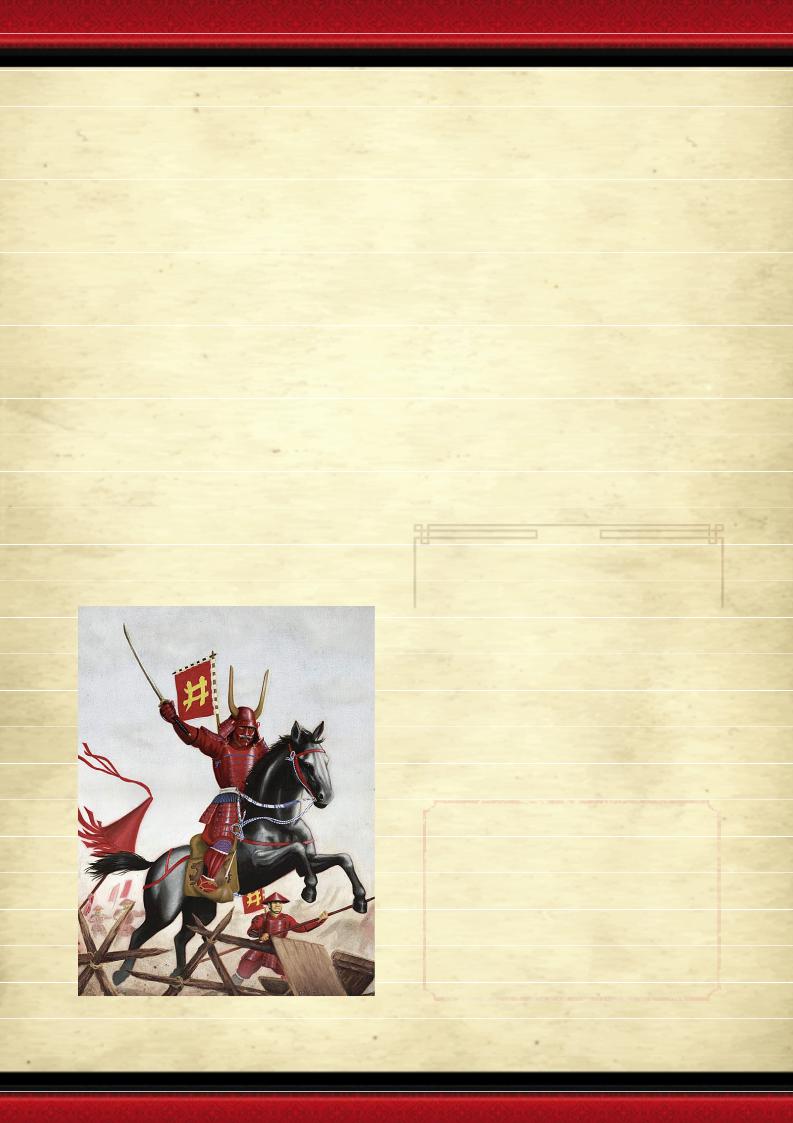
RED DEVILS
The Red Devils are a special order of S amurai, focusing only on the aspect of war and death, completely neglecting the other parts of the Way of the Warrior. They wear blood-red armours and banners, often decorated with skulls and bones of their fallen enemies as well as smearing their blood on their armour. They wear helmets with closed masks, each with the face of an Oni. They top their helmets with two large horns, from which they have gotten their name.
The Red Devils were founded by Tanek a Naomasa from the Taneka Clan. Being obsessed with gaining honour and glory in battle, he quickly r ose in prominence among the other less offens ive generals, and had soon made a name for himself. His army swelled with young recruits of impetuo us Samurai who sought to quickly rise to power or was simply consumed by the lust for battle.
His finest hour was to come at the Battle of Bloodied Souls, where his unit of bodyguards outpaced those of other generals, drawing the first blood o f that battle.
However, Naomasa was shot down on h is horse while charging together with his bodyguard a gainst the remnants of the opposing army. All of them died together with him, but the battle was wo n, and Naomasa would forever be remembered for his great actions, with his son taking upon himself to keep the code of the Red Devils alive.
Many Samurai would flock to his banner, wanting to relive those deeds and die ho nourable in battle like Naomasa.
The combination of the Red Devils’ unsurpassed abilities with the horse, their singular skills in battle, and their intense devotion turns these samurai from simple warriors into something more like unrelenting forces of nature. The Red De vils have the speed, mobility, and power of all T aneka cavalry, but they also have the strength of their convictions.
The Red Devils are very particular about who may join their ranks. Only samurai with years of service and outstanding martial skills are accepted, and on top of those requirements, all successful candidates must demonstrate truly exceptiona l piety, as determined by the sensei of the Red Devil dojo.
Today, the Red Devils have gained a lot of influence in Nippon, and the order draws in recruits from all the provinces. The Red Devils a re a terrifying foe to face on the charge, attacking with no disregard for their own safety, slaughtering anyone who dares stay before them and fight.
|
M WS BS S T W I A Ld |
||||||||
Red Devil |
4 |
4 |
3 |
4 |
3 |
1 |
4 |
1 |
8 |
Red Devil Chui |
4 |
4 |
3 |
4 |
3 |
1 |
4 |
2 |
8 |
Warhorse |
8 |
3 |
0 |
3 |
3 |
1 |
3 |
1 |
5 |
TROOP TYPE: Cavalry.
SPECIAL RULES: Way of the Warrior, Kenjutsu,
Death before Dishonour, F renzy.
Fearsome Charge: The Red Devils’ gruesome appearance combined with t heir fearful battle cry and reputation means only the most stout-hearted dare stand against their charge.
Red Devils causes Fear on a ny turn that they charge.
“He who is intent on dying can be murdered. He who is quick to anger can be insulted. He who is selfconscious can be humiliated. He who is compassionate can be troubled. But the commander whose mind is focused, and whose soul is taken up
by the strike, he will know victory.”
64

W AKO PIRATES
Pirates have long plagued the coast of N ippon, striking quickly against lone ships or coastal villages before retreating back out to sea and their hidden bases. Wako are men who have forsaken the code of bushido for a life of plunder and piracy, or peas ants who find themselves tired of the treatment of their lords. Some successful Wako pirates become so called “sea lords”, and even make out small clans of their own, seizing large areas as their fiefdoms and ruling them through their own clan structures. They extort to lls from passing ships for “protection” if they are feeling friendly or simply take what they want when the opportunity arises.
The Wako patrol the coast and inland w aterways, occasionally venturing out to sea in the hope of waylaying a Cathayan or Old World ship. Sometimes they even conduct raids on the mainlan d, carrying off valuables and people to ransom. They sail in black junks and are ruthless and fearless fighters, expert in combat at sea and the boarding of other vessels. Their bases are islands or hidden ports where they can hide from justice and the admiral of the Sho gun's fleet.
These reavers and their swift craft lurk in isolated coves and remote islands along the rock y coast and swoop down on rich merchants and unsuspecting kobune.
Wako are often little better than thieves and prey upon coastal trade mercilessly. Strangely, they never prey on the fishing boats, which are perhaps just too poor to whet a pirate's appetite. But then many a quiet fishing village holds darker secrets, and the nim ble boats catch more than fish when the opportunity allows. When crushed by taxes, it is very tempting to take the riches that sail by, and some peasant fisherme n turn pirate when the need takes them.
The Nipponese ability to deal with their pirate problem was hindered by the Clan War and the lack of a strong central government. The Cathayans, who have on the receiving end of many Wako depredatio ns, continually demanded that the Nipponese deal with the pirates, but each solution only seemed to halt them for a short while. Attacks on known Wako ports, m ass beheadings and even bans on foreign trade did not s eem to make much difference to the Wako.
However, with the reinstatement of a ne w Shogun, the Wako threat has been diminished some what. By forbidding peasants from owning weap ons, fewer are able to become Wako, and thus the threat has lowered, if not disappeared.
While Samurai generally hate the Wako with a passion, some Clans have seen the advantages o f hiring them as mercenaries in their armies. With the promise of an Imperial pardon and a share of the enem y loot, plenty of Wako take up these offers, knowing most Samurai are too bound by their honour to break their promises.
65
The Wako usually sail around the flanks of the enemy army where they can strike u nsuspecting enemy regiments in the rear as the battle rages on. Wearing little to no armour and armed with swords and bows, the Wako can be a large threat if not countered in time.
After the battle, the Wako ta ke their time to plunder the enemy corpses before disapp earing back to their ships, with many disgruntled looks from the Samurai. Still, it’s a low price to pay for bei ng able to hire some of the most feared sea farers this si de of the world.
|
M WS BS S T W I A Ld |
||||||||
Wako Pirate |
4 |
3 |
3 |
3 |
3 |
1 |
4 |
1 |
7 |
Bosun |
4 |
3 |
3 |
3 |
3 |
1 |
4 |
2 |
7 |
TROOP TYPE: Infantry.
SPECIAL RULES: Amb ushers, River Strider.
Distrustful: Wako and Sam urai are not known for getting along, even during their brief alliances. Each side is constantly worried about the possible betrayal of the other one, which in the c ase of Wako, is not often far from the truth!
Friendly units with the Way of the Warrior special rule and Wako both suffer -1 to t heir Leadership if within 6” of each other. Wako must re-roll successful panic tests caused by fleeing friend ly units with the Way of the Warrior special rule.
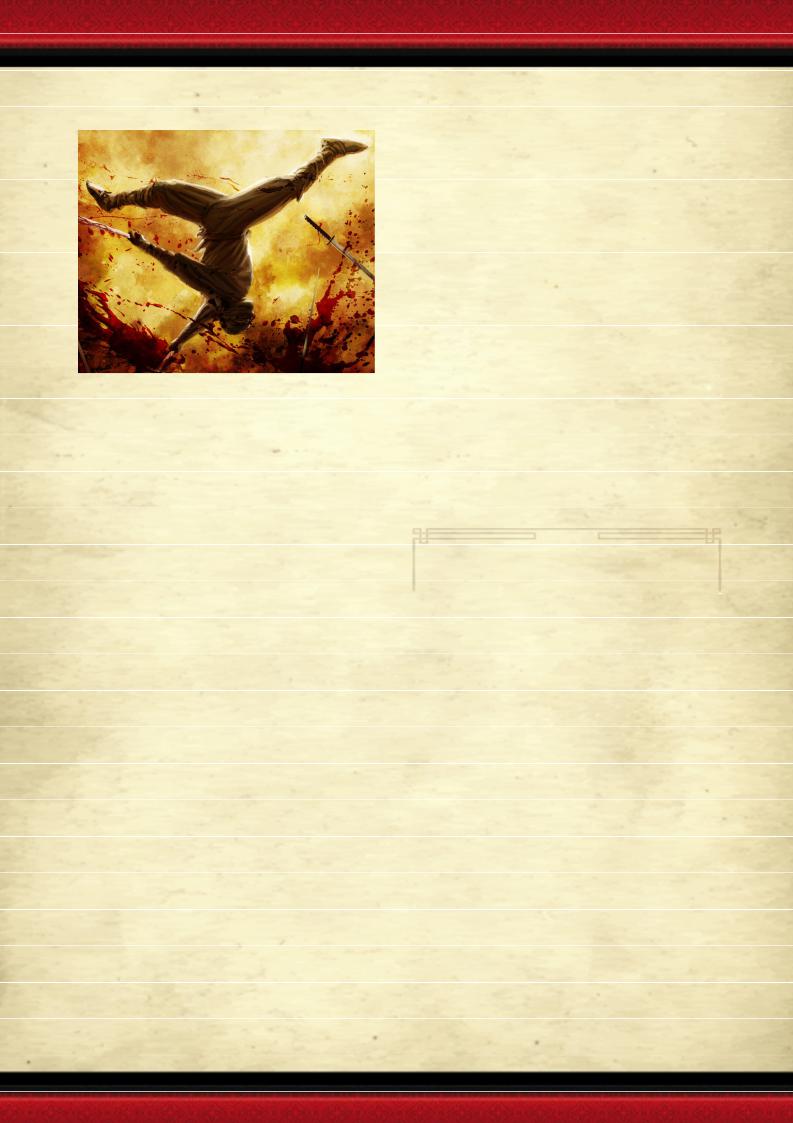
NINJA
Ninja mostly come from the Shinzei Cl an, although it has been rumoured that other clans hav e Ninja of their own. Due to the nature of their duties, N inja have to violate the tenets of Bushido at every turn. For this reason, Ninja groups usually adopt a slightly different code of honour. These vary from family to family, but almost always involve some form of the Three Oaths, originally devised by the Shinzei:
Secrecy – Ninja almost always operate under a cover identity or another. Often, even their ow n family does not know about their covert activities. T his protects not only the Ninja himself, but also his asso ciates.
Loyalty – A Ninja can only depend on his compatriots, and they only on him, making loyalty e ven more important than for normal samurai. He must also be prepared to deny allegiance to his lord when caught, and face the consequences alone.
Duty – A Ninja’s duty is even more arduous than for others, as it often alienates him from his friends and family. In addition, he must be ready to solve difficult tasks on his own, often at the price of his own life, without the prospect of eternal glory and veneration a bushi enjoys.
The skills of the Ninja are the product of a lifetime of intensive training, cunning a nd the clever use of misdirection. The ability to move about largely unseen on the battlefield means they appear from nowhere, launch an assault on an enem y general and then vanish before they are caught or killed. They are armed with throwing knives for short-ra nge attacks and their blinding grenades can disori entate an enemy for a short time, reducing their fighting ability. To remain as stealthy as possible, Ninja op erate in small numbers, so must avoid prolonged close combat because they cannot afford to take many casualties.
Though generally distrusted and loathed by the Samurai, some commanders see past the Ninjas’ lack of honour and see their uses on the battlefield. Groups of Ninja scouts ahead of the army, assassinate valuable targets, and harass the enem y supply lines.
|
M WS BS S T W I A Ld |
||||||||
Ninja |
5 |
5 |
4 |
3 |
3 |
1 |
5 |
1 |
8 |
Shadow Eye |
5 |
5 |
4 |
3 |
3 |
1 |
5 |
2 |
8 |
TROOP TYPE: Infantry.
SPECIAL RULES: Skirm ishers, Scouts, Ward save (6+).
BLOWGUN |
GRAPPLING HOOKS |
Blowguns firing poisoned darts are am ong the Ninja’s |
Ninja use grappling hooks to scale walls and buildings |
favourite weapons, able to cripple to to ughest foe. |
otherwise impassable for them. |
A blowgun has a range of 12”, strength 3, and fires 2x |
Ninja equipped with grappli ng hooks ignores penalties |
multiple shots. All shots made with a blowpipe are |
for impassable terrain like walls, rocks and building, |
poisoned. |
but not water and the like. Note that they may still not |
|
end their move within impassable terrain. |
CALTROPS |
SMOKE BOMBS |
Caltrops are an antipersonnel weapon made up of two |
|
or more sharp nails or spines arranged in such a |
The smoke bomb of the Ninja is a small eggshell filled |
manner that one of them always points upward from a |
with blinding powder, used to facilitate escape. |
stable base. |
|
|
At the end of any Close Com bat phase in which a unit |
The Caltrops may be used as a Stand and Shoot |
of Ninja take part, they may choose to use their Smoke |
reaction. The enemy unit charging them deducts D6” |
Bombs. On a 4+ the unit ma y disengage the combat. If |
from its charge move, as they must be careful not to |
they do so, the enemy canno t pursue them and they |
trample on the caltrops scattered on the ground. |
will rally automatically in their next turn. |
66
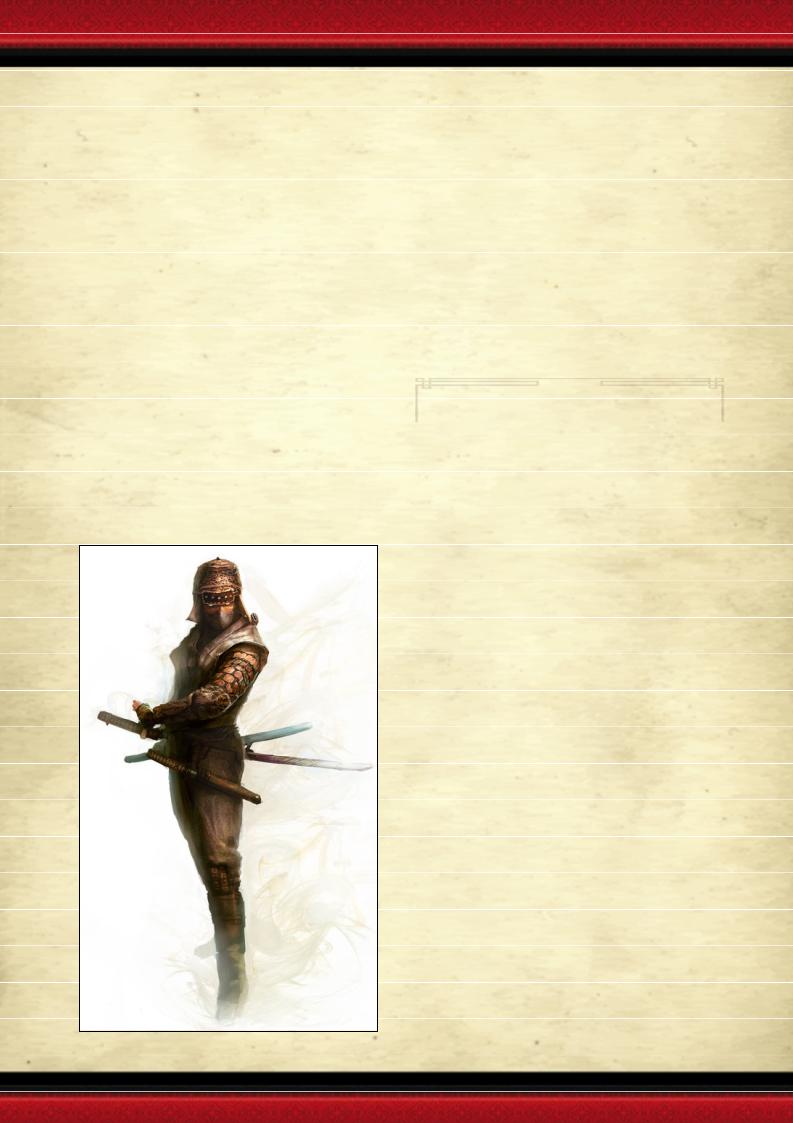
SHINOBI
The Shinobi are the most secretive school in the most secretive Clan in Nippon, and for good reason. The Shinobi are spies, and assassins. When diplomacy, strength of arms, and magic fail, it falls to the Shinobi to protect the Shinzei's interests.
Most Sarutori students are drafted from the other Shinzei schools when they begin to show great talent in stealth or the cold instincts that are so useful for an assassin. Most are instructed privately while they continue studies in other schools, adapt ing guises as samurai or courtiers as they continue their Shinobi training.
Optimally, a Shinobi has a full life and duties aside from those he learns in school. When his Clan calls upon him, his skills are ready, but until these deadly samurai hide in plain sight.
A Shinobi is trained to move silently, ki ll efficiently, and blend effortlessly into the shadows. They are also knowledgeable in all aspects of Nippon’s criminal underworld, for the duties often require them to seek aid or information there.
Above all else a Shinobi's most prized p ossession is his identity. A Shinobi conceals his true na ture from any whom he does not trust completely. Th e Empire of
67
Nippon hates ninja and thou gh the Shinobi do not consider themselves ninja, th ey do recognize that their tactics are so similar as to m ake little difference in the eyes of their enemies. Shino bi who are exposed must claim to be acting without the knowledge of the Shinzei Clan. They reveal no thing about their training or objectives.
If there is no possibility of escape, a captured Shinobi will take his own life rather than revealing the Shinzei's secrets under torture.
The Shinobi are the highest r anking of Ninja in Nippon. They are employed to eliminate enemy commanders, small units and war machines, and are a match for anyone in combat.
|
M WS BS S |
T W I A Ld |
|||||||
Shinobi |
5 |
7 |
6 |
4 |
4 |
2 |
7 |
3 |
9 |
TROOP TYPE: Infantry ( Character).
SPECIAL RULES: Always Strike First, Poisoned
Attacks, Ward save (4+), Scout.
Dishonourable: The Samur ai have a great enmity towards the Ninja of Nippon, and would never lower themselves to fight side by s ide with them. Shinobi may never join any units with the Way of the Warrior special rule.
Hidden: A Shinobi is a special type of character. He may begin the game hidden i n one of the following units: Ashigaru, Kabuki Doll s or Ninja. Make a note of which unit the Shinobi is hiding in.
A hidden Shinobi is not placed on the table during deployment, but is revealed later in the game. If his concealing unit is wiped out or flees from the battlefield before he is revea led, the Shinobi is also lost and counts as a casualty. The re is no other way the Shinobi can be harmed before he is revealed.
Hidden Shinobi may be revealed at the beginning of any of your turns, or at the start of any Close Combat phase. Declare that the unit c ontains a Shinobi and place the model in the front r ank. Displace a rank-and- file model to make room for the Shinobi. If the unit is in close combat, the Shinobi displaces any rank-and- file model in the unit that is i n contact with the enemy. If there are no rank-and-file models to displace in a suitable position, a command model or character must be moved to make room for the Shinobi.
A Killer not a Leader: Although Shinobi are character models, units in the Nippon army may not use a Shinobi's Leadership and a Shinobi can never be chosen to be your army's Ge neral.
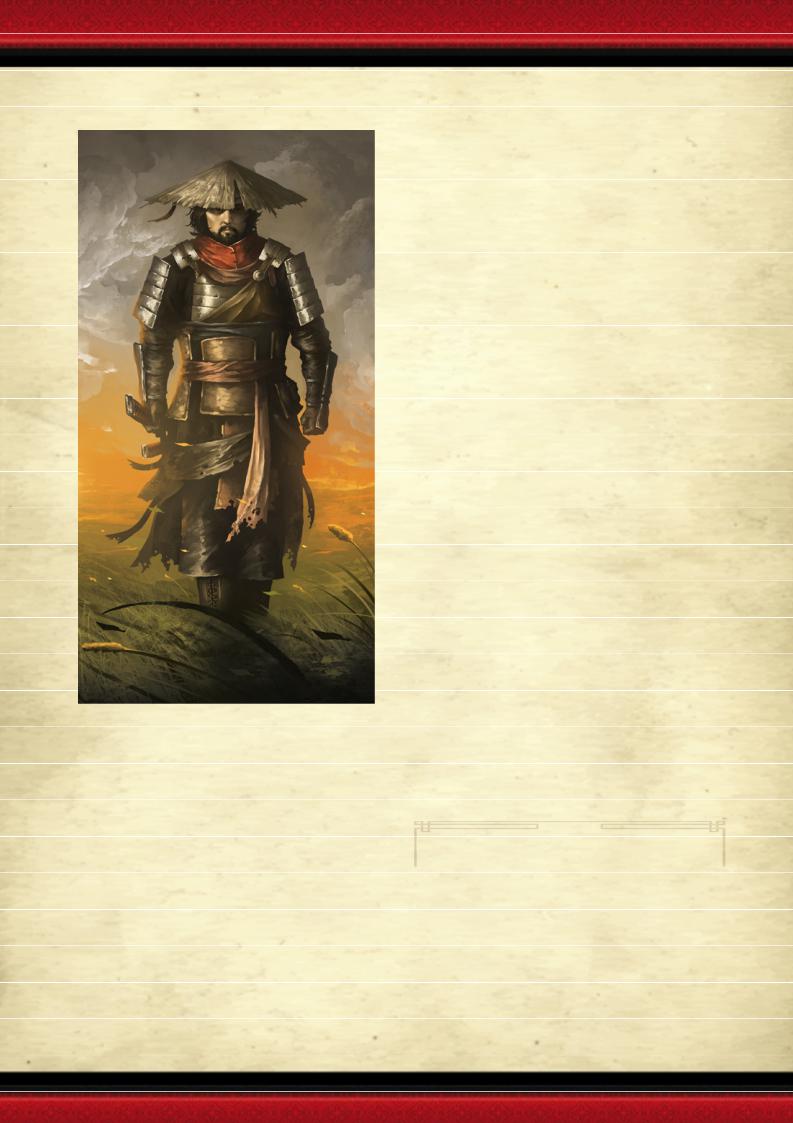
RONIN
No matter how prosperous or beleaguered the Empire becomes, there are always samurai who serve no master but themselves. To these samurai, known as Ronin, or "wave men", the notion of a life without duty is far worse than death. Some men are b orn to this lot, the child of a samurai who chooses not to recognize his offspring for whatever reason. Others a re cast out for failure, denied even the honourable red emption of seppuku.
Also known as the "Samurai without m asters", for individual reasons each Ronin has foun d themselves on the path of the mercenary. They are renegades, soldiers of fortune and wandering vagrants, but they are no less dangerous warriors than normal Samura i for it.
A samurai becomes masterless from the ruin or fall of his master, or after the loss of his master's favour or privilege. A samurai is forbidden to become employed by another master without his previous master's
permission. When the samurai's previous master dies without an heir, or is strippe d of his lands and title, the samurai is unemployable by other Daimyo.
In addition, a samurai can become Ronin if he is not recognized as an heir by his samurai parent, is outcast for a failure and denied seppuku, or is simply someone who has chosen to abandon his station.
Generally, a samurai will req uest to commit seppuku to absolve himself of whatever shame caused him to become Ronin, though this step could be forbidden by the samurai's Daimyo, if becoming Ronin were a punishment.
Traditionally, Ronin are gen erally regarded as disreputable and are frequen tly targets of humiliation and satire. In addition, Ronin often pose a serious threat, as the masterless life often degenerates into a life of thievery and malice. R onin bands frequently threaten settlements and com merce. This is a problem that arises somewhat regularly and that the magistrates of Nippon put forth every eff ort to quell.
Ronin exist outside the Celes tial Order. They are still samurai, but they are not subservient to any greater power. They wear the daisho, but they do not have the protection of even the eta wh o live under a Daimyo.
The Ronin roam Nippon see king their fate in battle and searching for ever greater tes ts of their swordsmanship and honour. If two powerful and well known Ronin happen to meet they may well duel to the death simply to test their skills. But despite their bloodthirsty trade, the Ronin share a deep mutual respect for each other and will often form into ban ds to offer their services in war.
Since there is no reason for a Samurai to exist without his honour, they want nothing more than to fall in the field of battle, thus relieving themselves of their shame by finding a worthy death. M ost commanders are happy to allow them to join the armies of Nippon, as they fight for practically not hing in return, and hopefully results in a few less Ronin in the world.
|
M WS BS S |
T W I A Ld |
|||||||
Ronin |
4 |
4 |
3 |
4 |
3 |
1 |
4 |
1 |
10 |
TROOP TYPE: Infantry.
SPECIAL RULES: Kenjutsu, Skirmishers,
Unbreakable.
Redemption: Every model in a unit of Ronin may issue and accept challenges a s if they were a Champion.
68
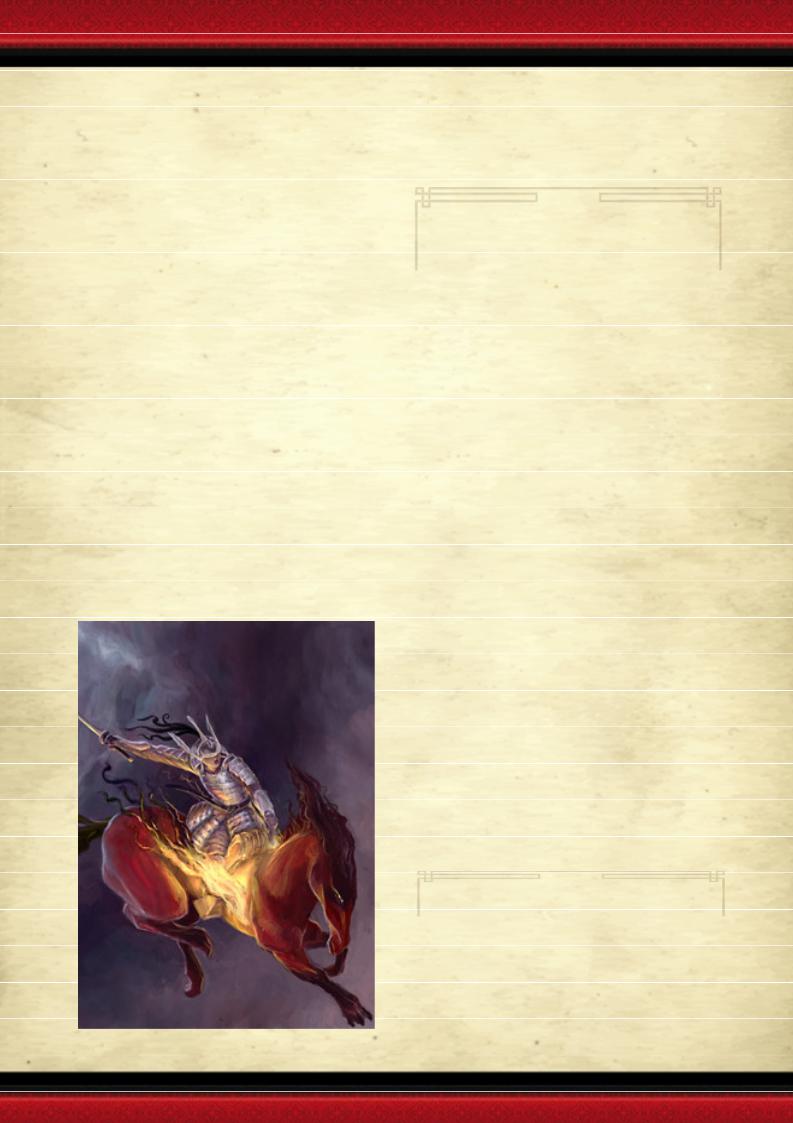
GREAT GUARD
Throughout Nippon’s history, the Empe rors have been protected by a group of extraordinary warriors handselected by the Emperor and his closest advisors. These individuals have been known as the Gre at Guard, and together they have protected the wives and families of countless Emperors over the course of more than one thousand years.
These greatest of Samurai are usually re cruited from Hatamoto or aspiring Taishos whom have proven themselves worthy in battle by protectin g their liege above all else. They are then selected through a great tournament held in the Imperial Courty ard once a year to determine which ones are deemed m ost fit to protect the Emperor. At least half of the potential recruits usually perish during this tournament, and as such only a few dozen Great Guards exists at any time.
These prestigious soldiers are then pres ented with the finest armour and weapons available in Nippon. Their lacquered steel armour covers their entire person, and offer significantly more protection than the normal armour worn by samurai. Likewise, the ir katanas have each been folded several hundred times during many months by the master smiths of Nippon, giving them a sharpness unmatched by any other wea pon, allowing to cut through steel with ease.
Rounding off their arsenal are there res plendent mounts, the Kirin, said to be among the most noble and virtuous of beasts. Atop these mighty creatures, the
69
Great Guard takes to the fiel d in times of need, riding upon the wind, and descending upon their enemies with unrelenting fury and determination to their cause.
|
M WS BS S T W I A Ld |
||||||||
Great Guard |
4 |
5 |
4 |
4 |
3 |
1 |
4 |
2 |
8 |
Citadel Sentinel |
4 |
5 |
4 |
4 |
3 |
1 |
4 |
3 |
8 |
Kirin |
9 |
4 |
0 |
4 |
4 |
3 |
5 |
2 |
8 |
TROOP TYPE: Monstrou s Cavalry.
SPECIAL RULES: Way of the Warrior, Kenjutsu (Great Guard only), Death before Dishonour, Fly,
Stubborn.
KIR IN
According to the legends of Nippon, the Kirin were born of a union of Air and E arth when the world was young. The story is typical of Nippon, and hence manifestly fanciful, but does reflect accurately the potency of these creatures. K irin are creatures of wholly unnatural composition, although appearing not unlike normal flesh and blood. They live amongst the devastating forces of lightnin g, storms and thunder. Kirins are aerial creatures w ho ride the roaring winds and storm clouds, bellowing like thunder and screaming great cracks of lightning through the electric-charged air.
Kirins have horse-like bodie s with long, flowing manes spun with sparks and slivers of lightning. In the centre of the creature’s forehead sp routs a long silver horn used to impale its foes. They are truly celestial beings of great intelligence and wis dom, and a symbol of swiftness and good fortune.
Kirins are noble creatures th at roam the sky in search of good deeds to reward or m alefactors to punish. A kirin superficially resembles a unicorn; it has the body of a stag, covered with lumin ous golden scales, a thick mane and tail of darker gold colour, deep violet eyes, and a pinkish horn and hoov es. Ki-tins sometimes establish lairs on high mountains or plateaus, simple on the outside but with luxuriant interiors. More often, however, they simply fly with the wind, never settling in any place for long.
|
M WS BS S |
T W I A Ld |
|||||||
Kirin |
9 |
4 |
0 |
4 |
4 |
3 |
5 |
2 |
8 |
TROOP TYPE: Monstrou s Beast.
SPECIAL RULES: Fly, M agical Attacks.
Impale Attack: The Kirin at tacks with +1 Strength when it charges into combat.

WA R MACHINES
MANGONEL
The Mangonel is the most widespread o f all modern Nipponese siege weapons: a large coun terweight propels missiles long distances via arcin g fire. Because of its small size and limited thr owing ability, the Mangonel does not have the power of a cannon, so rather than destroying the walls of a castle, it simply ignores them by hitting what’s on the ot her side. The Mangonel’s projectiles are small earthenware bombs, filled with gunpowder and placed in the bucket at the end. The fuse is then lit and the bomb is thrown in an arc over any obstacle. Hopefully, when the bombs hit the ground they explode, spreading flam es everywhere, panicking anyone nearby and setting fire to any surrounding buildings.
|
M WS BS S T |
W I |
A Ld |
||||||
Mangonel |
- |
- |
- |
- |
7 |
3 |
- |
- |
- |
Crew |
4 |
3 |
3 |
3 |
3 |
1 |
3 |
1 |
6 |
TROOP TYPE: War Machine (Ston e Thrower).
SPECIAL RULES:
Fire Bombs: All shots fired by a Mangonel have the Flaming Attacks special rule.
FLAMING AR ROW
In I.C. 2343, the Nipponese had their first contact with the Estalians, who soon esta blished the ‘nanban’ trade, providing the Nipponese with arquebuses and cannons. The Flaming Arrow is a light Nipponse cannon that wreaks havoc on enemy units. The weapon is exactly what its name suggests; a ba rbed projectile fired, in most cases, from an Estalian cannon, as the Nipponese have not yet developed effective artillery of their own. Each arrow is wrapped with a flammable covering and ignited, ripping straight thro ugh a regiment with ease. Flaming Arrows are slow to fire and relatively inaccurate, but anyone unfortunate to be hit will find himself skewered with imme nse force and set ablaze.
|
M WS BS S T W I |
A Ld |
|||||||
Flaming Arrow |
- |
- |
- |
- |
7 |
3 |
- |
- |
- |
Crew |
4 |
3 |
3 |
3 |
3 |
1 |
3 |
1 |
6 |
TROOP TYPE: War Machine (Cannon).
SPECIAL RULES:
Flaming Arrows: Flaming Arrows are fired using the rules for Cannons. However, hits are resolved like that of a Bolt Thrower (D3 Woun ds, loses 1 Strength for each model slain) with Strength 7. All hits from a Flaming Arrow have the Fla ming Attacks special rule.
70
